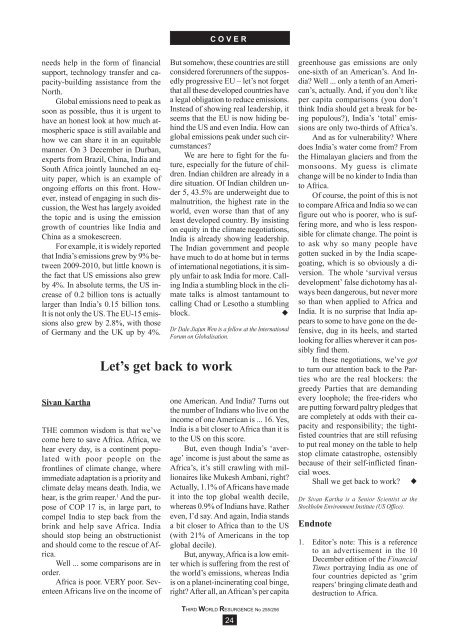Download - Third World Network
Download - Third World Network
Download - Third World Network
Create successful ePaper yourself
Turn your PDF publications into a flip-book with our unique Google optimized e-Paper software.
C O V E Rneeds help in the form of financialsupport, technology transfer and capacity-buildingassistance from theNorth.Global emissions need to peak assoon as possible, thus it is urgent tohave an honest look at how much atmosphericspace is still available andhow we can share it in an equitablemanner. On 3 December in Durban,experts from Brazil, China, India andSouth Africa jointly launched an equitypaper, which is an example ofongoing efforts on this front. However,instead of engaging in such discussion,the West has largely avoidedthe topic and is using the emissiongrowth of countries like India andChina as a smokescreen.For example, it is widely reportedthat India’s emissions grew by 9% between2009-2010, but little known isthe fact that US emissions also grewby 4%. In absolute terms, the US increaseof 0.2 billion tons is actuallylarger than India’s 0.15 billion tons.It is not only the US. The EU-15 emissionsalso grew by 2.8%, with thoseof Germany and the UK up by 4%.Sivan KarthaLet’s get back to workTHE common wisdom is that we’vecome here to save Africa. Africa, wehear every day, is a continent populatedwith poor people on thefrontlines of climate change, whereimmediate adaptation is a priority andclimate delay means death. India, wehear, is the grim reaper. 1 And the purposeof COP 17 is, in large part, tocompel India to step back from thebrink and help save Africa. Indiashould stop being an obstructionistand should come to the rescue of Africa.Well ... some comparisons are inorder.Africa is poor. VERY poor. SeventeenAfricans live on the income ofBut somehow, these countries are stillconsidered forerunners of the supposedlyprogressive EU – let’s not forgetthat all these developed countries havea legal obligation to reduce emissions.Instead of showing real leadership, itseems that the EU is now hiding behindthe US and even India. How canglobal emissions peak under such circumstances?We are here to fight for the future,especially for the future of children.Indian children are already in adire situation. Of Indian children under5, 43.5% are underweight due tomalnutrition, the highest rate in theworld, even worse than that of anyleast developed country. By insistingon equity in the climate negotiations,India is already showing leadership.The Indian government and peoplehave much to do at home but in termsof international negotiations, it is simplyunfair to ask India for more. CallingIndia a stumbling block in the climatetalks is almost tantamount tocalling Chad or Lesotho a stumblingblock.ÿuDr Dale Jiajun Wen is a fellow at the InternationalForum on Globalisation.one American. And India? Turns outthe number of Indians who live on theincome of one American is ... 16. Yes,India is a bit closer to Africa than it isto the US on this score.But, even though India’s ‘average’income is just about the same asAfrica’s, it’s still crawling with millionaireslike Mukesh Ambani, right?Actually, 1.1% of Africans have madeit into the top global wealth decile,whereas 0.9% of Indians have. Rathereven, I’d say. And again, India standsa bit closer to Africa than to the US(with 21% of Americans in the topglobal decile).But, anyway, Africa is a low emitterwhich is suffering from the rest ofthe world’s emissions, whereas Indiais on a planet-incinerating coal binge,right? After all, an African’s per capitagreenhouse gas emissions are onlyone-sixth of an American’s. And India?Well ... only a tenth of an American’s,actually. And, if you don’t likeper capita comparisons (you don’tthink India should get a break for beingpopulous?), India’s ‘total’ emissionsare only two-thirds of Africa’s.And as for vulnerability? Wheredoes India’s water come from? Fromthe Himalayan glaciers and from themonsoons. My guess is climatechange will be no kinder to India thanto Africa.Of course, the point of this is notto compare Africa and India so we canfigure out who is poorer, who is sufferingmore, and who is less responsiblefor climate change. The point isto ask why so many people havegotten sucked in by the India scapegoating,which is so obviously a diversion.The whole ‘survival versusdevelopment’ false dichotomy has alwaysbeen dangerous, but never moreso than when applied to Africa andIndia. It is no surprise that India appearsto some to have gone on the defensive,dug in its heels, and startedlooking for allies wherever it can possiblyfind them.In these negotiations, we’ve gotto turn our attention back to the Partieswho are the real blockers: thegreedy Parties that are demandingevery loophole; the free-riders whoare putting forward paltry pledges thatare completely at odds with their capacityand responsibility; the tightfistedcountries that are still refusingto put real money on the table to helpstop climate catastrophe, ostensiblybecause of their self-inflicted financialwoes.Shall we get back to work?uDr Sivan Kartha is a Senior Scientist at theStockholm Environment Institute (US Office).Endnote1. Editor’s note: This is a referenceto an advertisement in the 10December edition of the FinancialTimes portraying India as one offour countries depicted as ‘grimreapers’ bringing climate death anddestruction to Africa.THIRD WORLD RESURGENCE No 255/25624















